
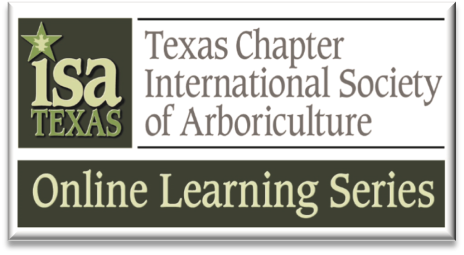
Bringing you the best scientists, educators and practitioners so you can keep up with the latest arboricultural research, information and technology—from wherever you are and whenever you want—all with our unique Texas trees in mind!
Here is how to watch the live webinar and get your ISA CEUs:
Couldn’t make it to the live session? Want to earn ISA CEUs?
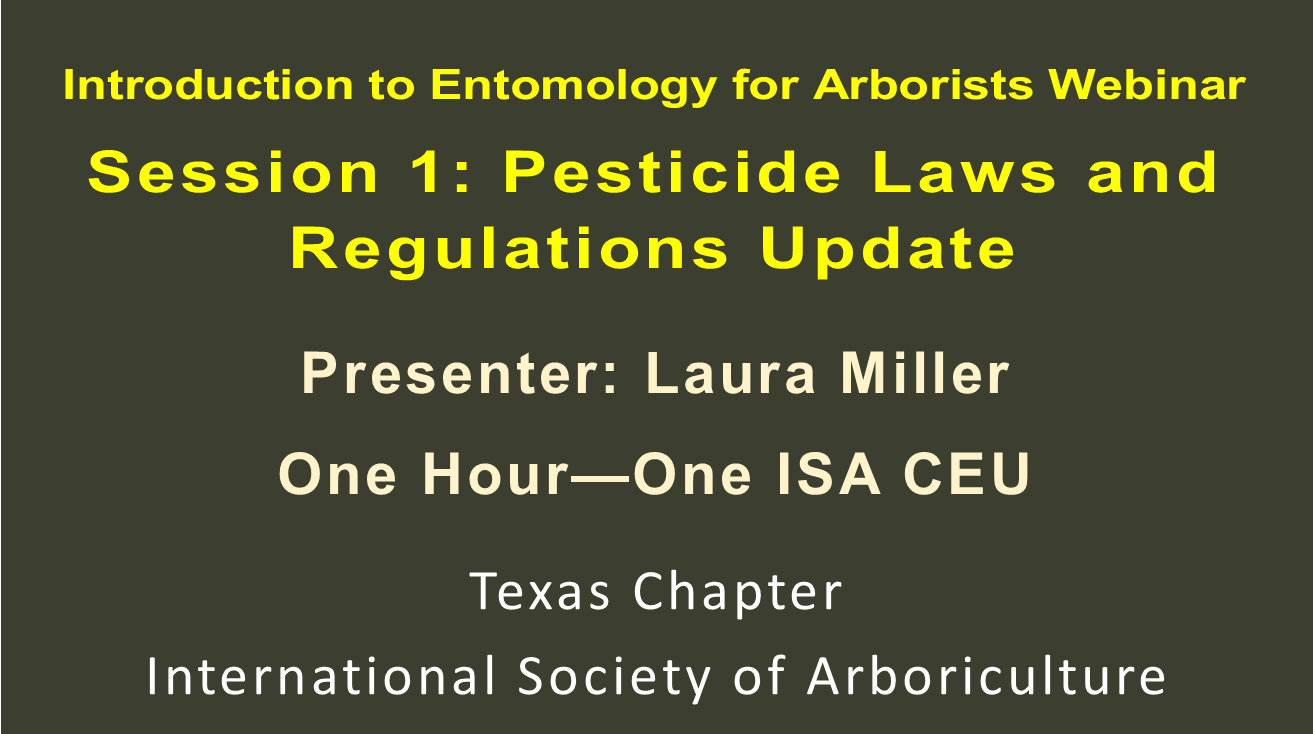
This presentation reviewed Texas pesticide licensing, record keeping and inspection rules.
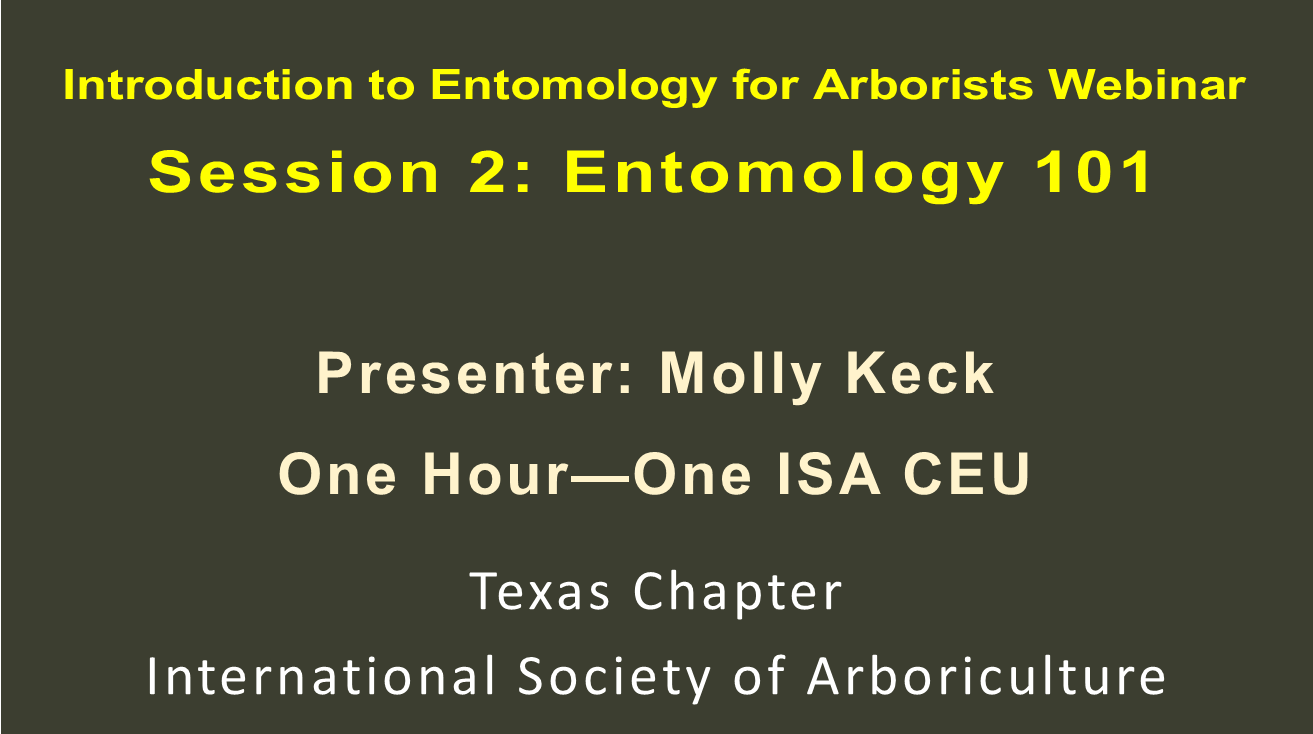
Learn the basics of entomology and building blocks to understanding insects. What is an insect versus other relatives, types of mouthparts and their damage, lifecycle and who does the damage, and how insects fall into the grand scheme of living things. This presentation contains terminology and information important to understanding Ento 102.
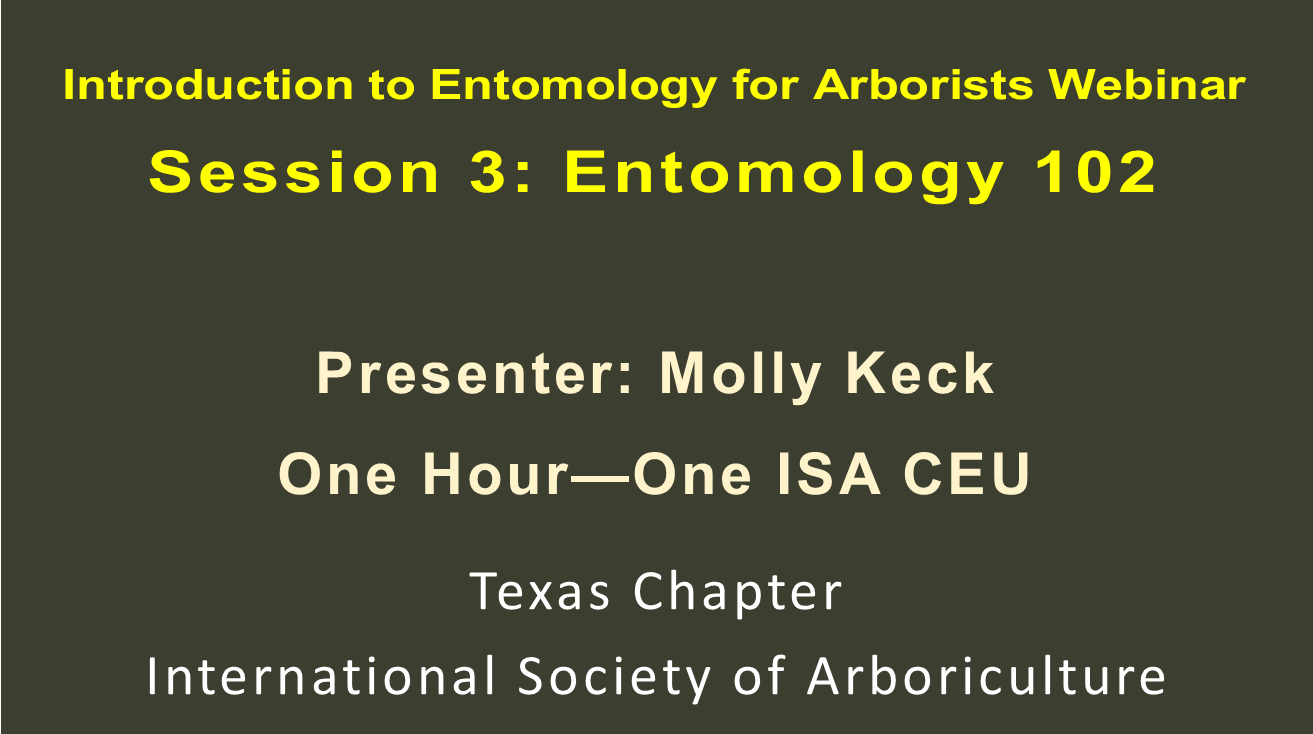
Common insect orders of landscape insects and how to identify them in the field. Knowing who is doing the damage, their lifecycle, and how they feed is the main battle in understanding how to manage those pests.
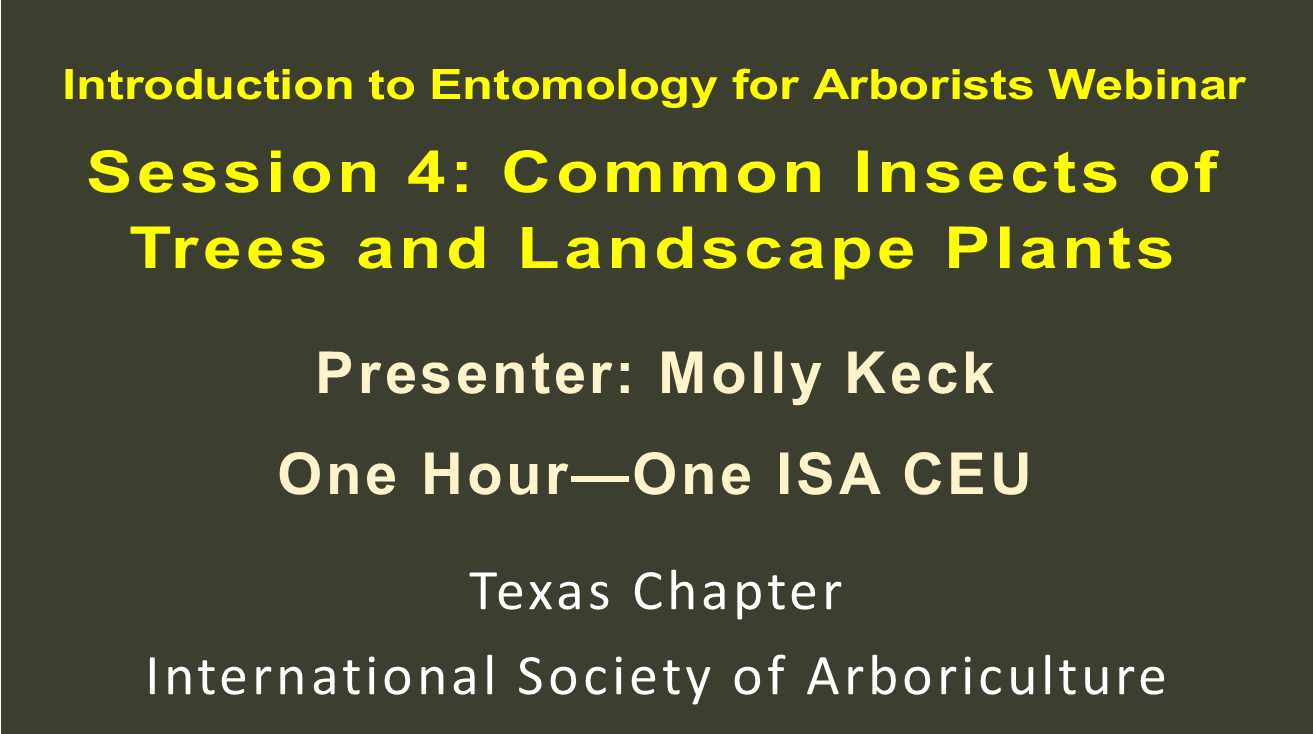
Now that you know the orders, let’s look into specific species and delve into the specifics of where they lay eggs, what they are attracted to, what damage they do, and why they are found in the landscape.
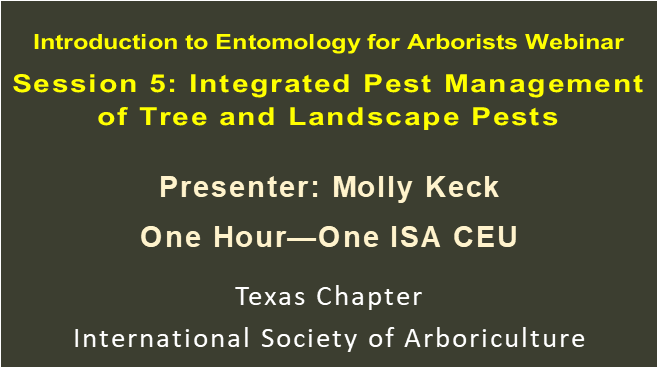
An integrated approach to pest management means using all available control tactics to bring pests to a tolerable level AND knowing which pests need treatment and what time. This saves you labor, costs, and is environmentally friendly. Learn how to manage common pests through cultural control, preventive measures, and chemical control options that are organic and traditional. Some pests do not require treatment – know when to spray and when to walk away!

Originally shown on Oct. 7, 2020 as Session 1 of the Virtual Texas Tree Conference.

In this session Dr. Johnson will discuss how forest trees connect to soils through complex relationships with pore space, organic matter, minerals and microbial life. Urban trees often struggle when these relationships break down because of compaction and organic matter losses. He discusses how we can reconnect trees with soils and reestablish these relationships through practices which reestablish soil structure, increase organic matter and balance soil chemistry. Originally shown on Oct. 8, 2020 as Session 2 of the Virtual Texas Tree Conference.

In part one, Tree Risk and Arborist Responsibility?, Skip Kincaid, Executive Director of the Southern Chapter of ISA, St. Louis, Missouri describes a framework for arborists to become better skilled and gain confidence in performing tree risk assessment. While the ISA Tree Risk Assessment (TRAQ) credential is a widely accepted tool and provides an excellent framework, some arborists are still wary of accepting an assignment that includes tree risk assessment, especially if a report is needed. A checklist of items is discussed that will reduce the anxiety associated with performing tree risk assessment. In part two, Conflict Resolution, Dr. Emily Landon, Professor, St. Mary’s School of Law, San Antonio and Attorney, Office of the Texas Attorney General, Austin will discuss how we all deal with difficult people. Learn how to learn how to grow your conflict resolution skills from an expert in alternative dispute resolution. Originally presented as Session 3 of the Virtual Texas Tree Conference on Oct. 14, 2020.

In part one, Emerald Ash Borer and You, Allen Smith, Forest Health Coordinator, Texas A&M Forest Service reviews Emerald Ash Borer (EAB) biology, ecology, identification, control and legal ramifications. This presentation examines EAB in depth and look at all aspects of the insect including identification and its associated pitfalls, what happens when the presence of EAB is confirmed, regulations associated with EAB and the processes procedures that should be followed when dealing with EAB. The current status of EAB in Texas is discussed including where it is and what is being done about it. In part two, EAB: To Treat or Not To Treat - That is the Question, Erik Lindberg, Lead Technical Advisor, Rainbow Treecare Scientific Advancements, Minnetonka, Minnesota notes that Emerald ash borer has arguably been the most devastating invasive insect in the last 18 years since it was first found in Michigan in 2002, and was confirmed in Texas in 2016. As it continues to spread to new communities, it becomes vital that municipalities have a plan in place to effectively manage it. This presentation discusses the impact of EAB, sign/symptoms, determining municipal budget allocations, how to determine which trees to target, and a toolbox approach to manage EAB. Originally shown Oct. 15, 2020 as Session 4 of the Virtual Texas Tree Conference.

In part one, Diagnosing and Managing Abiotic Disorders, Emmett Muennink, Arborjet South Central Technical Manager will review practical approaches to diagnosing trees and implementing proper protocols for managing various abiotic disorders. He discusses drought, nutrient deficiencies, herbicide injury, and construction stress. In part two, Trees and Construction: Building for Long Term Tree Survivability, David Dechant, Lead Arborist and Soil Scientist, Davey Tree Experts, Atlanta discusses his work as a consulting construction arborist, who works exclusively to implement natural design solutions to protect valuable tree, soil and water resources on construction projects. Various aspects of project design and management will be discussed as well as relevant ANSI Standards including Soil Management, Site Development and Construction, Root Management and the implementation of these standards to ensure project success. Examples obtained from current and past projects will also be presented. Originally show on Oct. 21, 2020 as Session 5 of the Virtual Texas Tree Conference.

What’s wrong with this tree? This can be both your favorite question and your hardest question to answer. Join the experts and your peers for presentations, samples and discussions to comprehensively address the topic of tree and landscape diagnosis from several different perspectives: The Tree Scientists: What is tree diagnosis and what are the trees responses to insect and diseases and how do symptoms develop? The Field Arborist: How do you diagnose tree health problems in the field? The Diagnostic Lab Clinician: How do plant problems get confirmed in the lab? These perspectives were covered in two, three-hour sessions and include a recorded question and answer session with the experts. This Virtual Edition offers several exciting features including diagnosis in the field and a tour inside the Plant Diagnostic Lab.
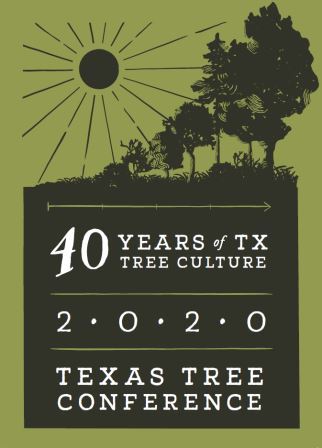
What’s wrong with this tree? This can be both your favorite question and your hardest question to answer. Join the experts and your peers for presentations, samples and discussions to comprehensively address the topic of tree and landscape diagnosis from several different perspectives: The Tree Scientists: What is tree diagnosis and what are the trees responses to insect and diseases and how do symptoms develop? The Field Arborist: How do you diagnose tree health problems in the field? The Diagnostic Lab Clinician: How do plant problems get confirmed in the lab? These perspectives were covered in two, three-hour sessions and include a recorded question and answer session with the experts. This Virtual Edition offers several exciting features including diagnosis in the field and a tour inside the Plant Diagnostic Lab.
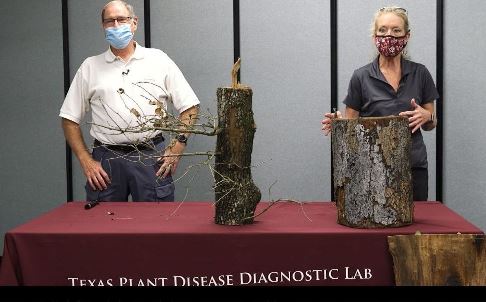
Dr. Appel and Sheila have re-imagined their What's Up Doc tree disease sample table quiz from the Texas Tree Conference and prepared a special bonus video and quiz for you. Watch the video (55 minutes and it's free) and if you take the online quiz here (27 questions) and get an 80% or above, we will send in your information to ISA so you receive one ISA CEU. Dr. Appel and Sheila will go over the answers in the Quiz Review webinar.
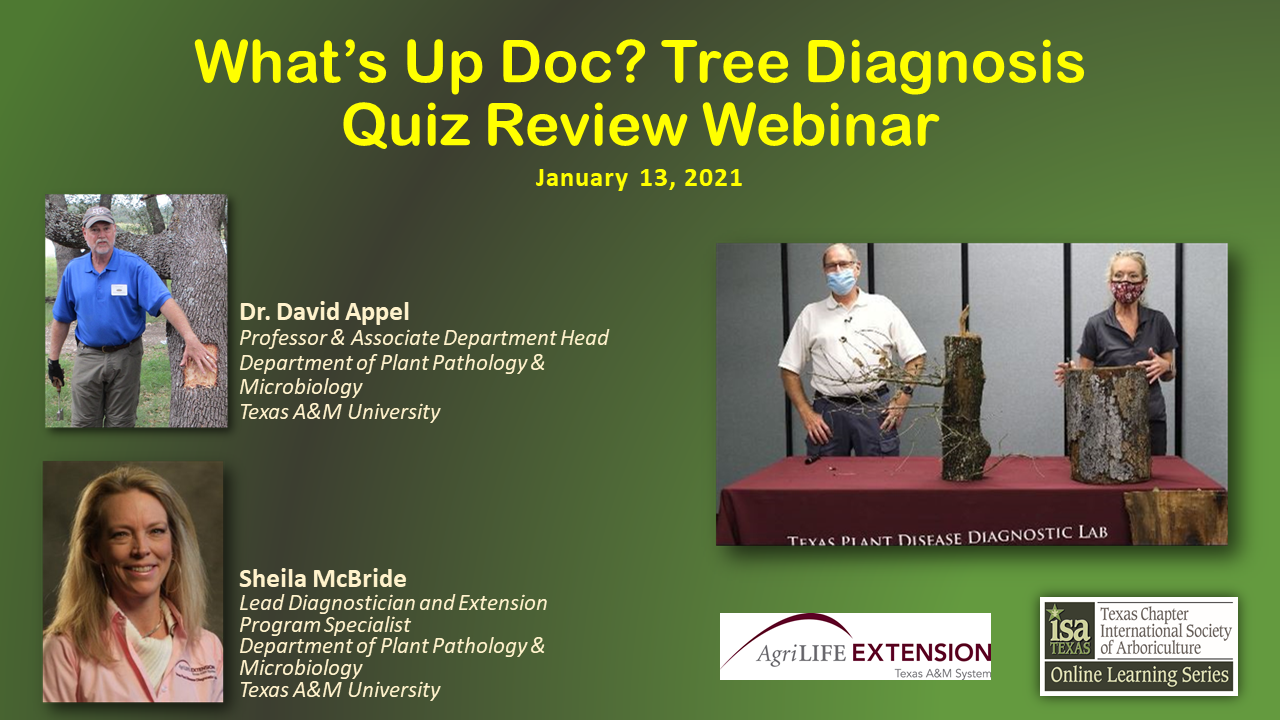
Join Dr. David Appel and Sheila McBride for the Tree Diagnosis Quiz Review on January 13, 2021. The popular 'What's Up Doc' tree diagnosis sample table from past Tree Academy's in Waco has been reimagined so that you can view it as an online video. Dr. Appel and Sheila encourage you to take the twenty seven (27) question quiz (free and link below) before you attend the Quiz Review Webinar. In this review webinar, will answer the quiz questions. The samples covered in the quiz are all described in Academy Sessions A & B (links above) so it is best to watch these sessions before you view the sample video and take the quiz. If you would like to receive one ISA CEU for watching the Tree Diagnosis Quiz video, just take the online quiz during or after you watch the video. You can take the quiz as many times as you like but you will need to score 80% or above to get the CEU. If you get 80% or above, the Texas Chapter ISA will submit your CEU information to ISA. Originally shown on January 13, 2021.
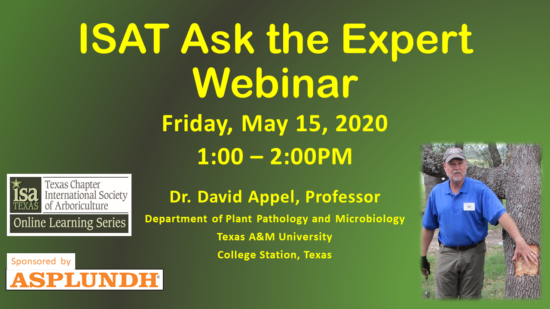
As an arborist, one of the most common questions you are asked is: “What’s wrong with my tree?” Have you ever wished you had an expert at your elbow to help? Now you have that chance. Dr. David Appel answered diagnosis questions and talked about diagnostic procedures using real life scenarios that your peers sent in in this one-hour webinar.
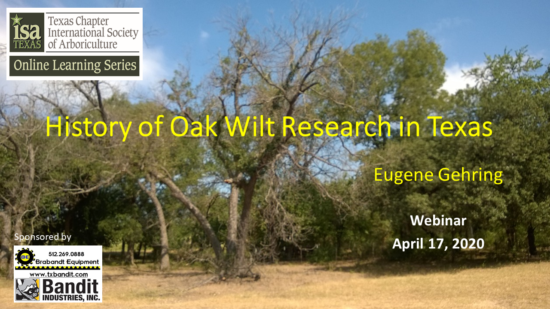
Did you ever wonder when oak wilt was discovered in Texas? Who first described oak wilt symptoms? How we know how fast it moves and where we got our sampling, testing, trenching and injection protocols? Millions of Texas oaks have been killed in the battle with oak wilt and the history of our current understanding of this epidemic is a true scientific detective story. This webinar will show you how science has been used to reveal the secrets of oak wilt and how the work of dedicated scientists and practitioners has led to our latest understanding of oak wilt disease identification and management techniques.

Click on the picture above to register and view One-hour (one CEU) webinar ($20 fee). Test and improve your Texas tree diagnosis skills! Join Dr. David Appel and Sheila McBride for the online Tree Diagnosis Quiz Review. In this pre-recorded webinar, they will review the answers to the Texas tree diagnosis video quiz.